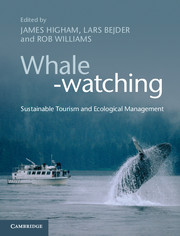Book contents
- Frontmatter
- Dedication
- Contents
- Acknowledgements
- List of contributors
- List of abbreviations
- 1 Tourism, cetaceans and sustainable development
- Part I The historical and contemporary contexts
- Part II Human dimensions of whale-watching
- 7 The whaling versus whale-watching debate
- 8 Iceland and the resumption of whaling
- 9 Green messengers or nature's spectacle
- 10 Whale-watching
- 11 What's in it for the whales?
- 12 Integrating traditional ecological knowledge and community engagement in marine mammal protected areas
- Part III Ecological dimensions of whale-watching
- Part IV Sustainable management: insights and issues
- Index
- Plate Section
- References
8 - Iceland and the resumption of whaling
An empirical study of the attitudes of international tourists and whale-watch tour operators
from Part II - Human dimensions of whale-watching
Published online by Cambridge University Press: 05 April 2014
- Frontmatter
- Dedication
- Contents
- Acknowledgements
- List of contributors
- List of abbreviations
- 1 Tourism, cetaceans and sustainable development
- Part I The historical and contemporary contexts
- Part II Human dimensions of whale-watching
- 7 The whaling versus whale-watching debate
- 8 Iceland and the resumption of whaling
- 9 Green messengers or nature's spectacle
- 10 Whale-watching
- 11 What's in it for the whales?
- 12 Integrating traditional ecological knowledge and community engagement in marine mammal protected areas
- Part III Ecological dimensions of whale-watching
- Part IV Sustainable management: insights and issues
- Index
- Plate Section
- References
Summary
This chapter investigates how the resumption of Icelandic whaling has impacted the whale-watching tourism industry in Iceland viewed both from a demand side and a supply side. The impact on international tourists and domestic whale-watching tour operators’ attitudes were subjects of a case study from Iceland in 2007. After an introduction to Icelandic whale-watching and the Icelandic whaling situation, the results of this case study are presented. In the concluding section the development of whale-watching tourism in Iceland from 1995 to 2009 is viewed and analysed through these two perspectives.
Whaling versus the whale-watching tourism industry
For a number of reasons, the coexistence of whaling and whale-watching has been described as incompatible (Hoyt & Hvenegaard, 2002). Removal of whales and disturbances or changes to their regular activities are direct effects of whaling. Whaling will thus reduce the number of existing whales for whale-watching at the same time as it can cause avoidance responses to boats in several ways, such as increases in dive intervals (Baker et al., 1988; MacGibbon, 1991; Janik & Thompson, 1996) and changes in movement and direction (Edds & MacFarlane, 1987; Salvado et al., 1992; Bejder et al., 1999; Nowacek et al., 2001) which are caused by the presence and navigation of vessels on the water in proximity to animals (Constantine, 2001). Other potential implications of the coexistence are negative attitudes towards the destination image by whale-watchers as well as other tourists. There are, however, some proponents of the Icelandic resumption of commercial whaling who say that it is possible for commercial whaling and whale-watching to coexist and that money can be gained from both whaling and whale-watching (e.g. Moyle & Evans, 2001 cited in Parsons & Rawles, 2003). In Iceland and Norway, the whale-watching industry exists side by side with the whaling industry.
- Type
- Chapter
- Information
- Whale-watchingSustainable Tourism and Ecological Management, pp. 95 - 109Publisher: Cambridge University PressPrint publication year: 2014



